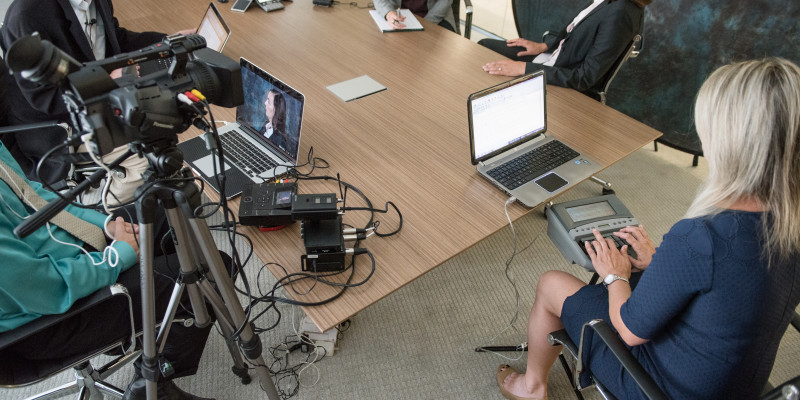How to Pick the Best Legal Videography Service for Your Requirements
How to Pick the Best Legal Videography Service for Your Requirements
Blog Article
Exploring the Devices of Legal Videography: Introduction Its Operation in Safeguarding Authentic Visual Testament for Judicial Procedures
In the world of judicial proceedings, the role of legal videography stands as a foundation in protecting and presenting aesthetic proof. As innovation remains to development, the devices behind lawful videography have become significantly complex, supplying a critical layer of authenticity to testimonies caught on video clip. By delving into the operational ins and outs of legal videography, one can reveal the careful processes that safeguard the stability of aesthetic proof presented in courtrooms - Legal Videography. This expedition not just clarifies the historic evolution of lawful videography yet also means the future trends that might further transform how aesthetic testimonies are promoted in the world of justice.
Historical Evolution of Legal Videography
Checking out the historical progression of legal videography exposes a substantial improvement in the recording and discussion of visual proof within the lawful landscape. In the past, legal process heavily relied upon composed photos and transcripts to record events and offer evidence. Nevertheless, with the arrival of video innovation, the lawful market observed a paradigm change in how aesthetic statement was recorded and offered.
The development of legal videography can be traced back to the late 20th century when innovations in video clip recording equipment made it much more obtainable for use in courtrooms. This technological improvement not only enhanced the accuracy and reliability of aesthetic proof but also transformed the method cases were presented to judges and juries (Legal Videography). Lawyers began to recognize the influential power of video clip recordings in communicating emotions, nuances, and non-verbal cues that created records or photos alone can not record successfully

Innovation Improvements in Video Paperwork
What crucial technical developments have transformed video documentation in the legal area? The lawful area has seen considerable developments in video documentation technology that have boosted the authenticity and integrity of visual proof in judicial process. One of the key advancements is high-def (HD) video recording capabilities, which provide crystal-clear images and sharp information that are critical for precisely catching testimonies, faces, and other visual signs. In addition, the combination of timestamping and metadata functions in video documentation devices has actually allowed exact documents of when and where the video clip was recorded, making sure the integrity of the evidence provided in court.
Additionally, advancements in video clip encryption and watermarking innovations have actually reinforced the safety and security and tamper-proof nature of video clip evidence, safeguarding it versus unauthorized modifications or tampering. The introduction of cloud storage space remedies and remote accessibility capabilities has streamlined the storage, retrieval, and sharing of video proof, assisting in smooth cooperation amongst lawful professionals and ensuring efficient access to vital visual statements when needed. These technical improvements in video clip paperwork have actually undoubtedly revolutionized the legal field, enhancing the precision, integrity, and admissibility of visual proof in judicial process.
Duty of Lawful Videographers in Court Settings
The advancement of video documentation technology in the lawful field has demanded a critical duty for legal videographers in courtroom setups, making sure the integrity and integrity of visual testimonies offered during judicial procedures. Legal videographers play a basic function in capturing and maintaining accurate visit aesthetic evidence that can be crucial in lawsuit. Their responsibility encompasses establishing devices, recording process, and producing high-grade video clips that precisely reflect the occasions in the courtroom.
In court settings, legal videographers must comply with strict standards and standards to preserve the credibility of the visual document. They must possess an eager eye for detail and a detailed understanding of legal treatments to ensure that the video footage they record is a true depiction of the occasions that transpired. Furthermore, lawful videographers often work very closely with legal teams to make sure that the video evidence straightens with the case's needs and can be successfully offered in court to sustain the legal debates being made. Overall, the duty of legal videographers in court room settings is vital in maintaining the concepts of important source justice and ensuring the transparency of legal procedures.

Ensuring Admissibility and Integrity of Video Clip Evidence
To maintain the integrity of visual evidence provided in lawful process, making sure the admissibility and honesty of video evidence is an important duty for lawful videographers. Admissibility refers to the acceptance of evidence by the court, and for video proof to be permissible, it must meet specific requirements. Lawful videographers play a critical role in guaranteeing that the videos they catch follow the regulations of proof, such as authenticity, relevance, and reliability.
Stability of video clip evidence entails keeping the originality and accuracy of the footage from the time it is recorded till it exists in court. This consists of firmly keeping the video data, documenting the chain of custodianship, and stopping any type of tampering or alterations. Lawful videographers have to follow stringent procedures to guarantee the honesty of the video clip evidence web and prevent any obstacles to its credibility.
Future Trends in Legal Videography
Given the increasing dependence on innovation in legal process, legal videographers are poised to welcome ingenious developments forming the future of aesthetic testimony capture and discussion. One of the prominent fads coming up is the integration of digital truth (VR) and boosted truth (AR) technologies right into legal videography. These modern technologies have the prospective to revolutionize just how visual evidence is offered in courts, permitting courts and courts to immerse themselves in the scene of the crime or occurrence.
Furthermore, making use of synthetic knowledge (AI) algorithms for video clip analysis is anticipated to streamline the procedure of reviewing and examining large amounts of video clip footage. AI can assist in identifying key moments, abnormalities, and patterns within videos, improving the efficiency of lawful investigations.

Verdict
In final thought, legal videography has played an essential duty in offering genuine visual proof for judicial proceedings. With technological improvements and the knowledge of lawful videographers, the stability and admissibility of video clip proof are guaranteed in court room setups. As legal videography proceeds to evolve, it will certainly be important to maintain standards that keep the accuracy and dependability of aesthetic statement for the future of legal process.
Examining the historic progression of lawful videography exposes a substantial improvement in the capturing and presentation of aesthetic evidence within the legal landscape.The advancement of video documents technology in the lawful area has necessitated an important duty for legal videographers in court setups, guaranteeing the stability and integrity of aesthetic testaments offered during judicial proceedings. Additionally, legal videographers commonly function very closely with lawful groups to make certain that the video clip proof straightens with the instance's needs and can be effectively presented in court to support the legal debates being made.To keep the reliability of visual evidence presented in lawful procedures, guaranteeing the admissibility and honesty of video clip proof is an essential duty for lawful videographers. As legal videography continues to develop, it will be essential to copyright criteria that keep the precision and dependability of visual testimony for the future of lawful procedures.
Report this page